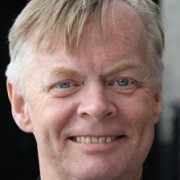Although the Netherlands is a rather small country, cultural differences in the country were rather great. Through the first half of the twentieth century, there was a great cultural distance between the Catholic south and the Calvinist north and west of the Netherlands. So being born in 1950, with the very Catholic name Johannes George Boudewijn Maria Rohlof, in Hilvarenbeek, a small Dutch town next to the Belgian border, I experienced a sort of culture shock when I started medical school in the university city of Leiden, located in the Calvinist western region of the country.
Before that, my secondary education was in Tilburg, in the Catholic south of the Netherlands. I had a classical secondary education, as was usual in the Netherlands in those years, including Greek, Latin and three modern languages: English, French and German.
It was during my medical studies that I first encountered immigrants in the community: labourers from Morocco and Turkey. Being politically engaged at university, I was a member of the neighbourhood council in a sector of Leiden where a lot of migrants lived. I worked toward getting better living conditions and educational opportunities for the immigrant group.
In addition to Morrocan and Turkish immigrant groups, during that period a lot of people from the former colonies of the Dutch Antilles in the West Indies and from Surinam, in northern South America ,migrated to the Netherlands, and as a result, the country began to be more racially diverse. This process has increased steadily over the last four decades, to the extent that there are now about two million people of foreign origin (first and second generation) in the national population of 17 million, and 7.5% of the total population of the Netherlands is foreign born from a non-European background.
After graduating from medical school, I started residency training in psychiatry at the psychiatric hospital of Leiden University, where I got experience in biological psychiatry as well as in different types of psychotherapy: cognitive behavioural, Rogerian, group dynamic, and analytic. My residency thesis was on group therapy with chronic pain patients.
When I became licensed as a psychiatrist, in 1982, I was offered a position at the city psychiatric hospital of ‘Endegeest’, near Leiden. A large proportion of the patients treated at this hospital came from the small fishing towns and villages along the North Sea coast. From 1985 to 1996, I worked as a psychiatrist in the outreach service of the Community Mental Health Centre, in the fishing town of Katwijk, one of the most closed communities in the country, where my cultural interest in psychiatry was further developed.
Not only did my patients from these fishing communities have strongly held beliefs in the influence of the devil, but also we as mental health workers had to cope with and work collaboratively with orthodox Protestant ministers, some of whom were strongly opposed to mental health care.
My interest in the growing number of immigrants and refugees in the Netherlands resulted in my appointment in the eighties to the board of the local Association of Assistance to Refugees. Beginning 1992, I was appointed as a psychiatrist at the Pharos Foundation in Amsterdam, a nation wide mental health program for refugees. There, my colleagues and I organized workshops and lectures about the mental health care of refugees. This experience led us to write several books and book chapters, and over fifty articles, about the mental health care of refugees and, more generally, about transcultural psychiatry; mostly in the Dutch language. In 1999, together with Mia Groenenberg and Coen Blom, I wrote a book about the mental health care of refugees. In 2002, Ria Borra, Rob van Dijk and I edited a book titled; Culture, Classification and Diagnosis, that included a text in English of a culturally competent interview. In 2005 I edited a book about Group Therapy with Refugees.
Since 1999, I have had a position at Centrum ’45; the national centre of expertise for the treatment of victims of persecution, war and violence. At the branch of Centrum ’45 where I work, psychiatric treatment is provided to refugees from more than 45 different countries. The Centre has an education and research component, organized in collaboration with Leiden and Utrecht Universities. One of our research topics is somatization in traumatised refugees. The Centre is also a training institute for residents in psychiatry.
Working with refugees, you experience cultural issues in psychiatric care in your day-to- day clinical practise. As a result, my colleagues and I became convinced that the time had come to share this interest and experience with other psychiatrists.
Although there had been some interest in cultural psychiatry and some conferences had been held on this topic, especially on working with immigrants and refugee populations in The Netherlands, there was no national organization that focused on cultural issues in psychiatry. In 2001, Ferdinand Thung ( who died in 2005 ), Pim Scholte and I founded the Dutch Section on Transcultural Psychiatry, and brought together Dutch scholars and practitioners in this field. The chair and co-chair of the Section were Joop de Jong and Frank Kortmann, who are professors of transcultural psychiatry at the universities of Amsterdam and of Nijmegen.
The Section on Transcultural Psychiatry has to date organised numerous national conferences and one international conference, including discussions about the place of culture in psychiatric research and education, and has published reports, like on scientific progress in transcultural psychiatry. The Section also has an e-mail newsletter that serves as a forum for people interested in cultural psychiatry issues. Another part of the Section’s activities is its involvement in the Scientific Committee of the Netherlands Psychiatric Association, which is responsible for the scientific programme of the annual meetings of the Association.
The Section has 120 members, 100 of whom are psychiatrists and the other 20 are medical anthropologists, psychologists and other mental health professional staff. In 2011 the Section became an official Division of the Netherlands Psychiatric Association.
In 2006, the Section on Transcultural Psychiatry of the Netherlands Psychiatric Association wanted to encourage its members’ participation in the rapidly growing international organisations of cultural psychiatry, such as their involvement in the WPA- Transcultural Psychiatry Section conference in Vienna, in April, and in the 1st World Congress of Cultural Psychiatry in Beijing, in Sep.
As Secretary of the Section, it was my responsibility to maintain communication within the Section, and between the Section and other organisations interested in cultural psychiatry. A central part of this task was maintaining contact through the World Wide Web. My initial training in website design enabled me to build a website for the Section, linked to my personal website:www.rohlof.nl The website of the Netherlands Association for Psychiatry also publishes news about the Section, in Dutch:www.nvvp.net
As Board Member, Treasurer, Secretary and Chair of the Transcultural Section of the WPA I served from September, 2008 till September, 2014. In these years the Section has been quite active organising conferences, writing journals, performing scientific research, and bringing together scholars of the field of Transcultural Psychiatry.
October 5, 2006, revised October, 2014.

